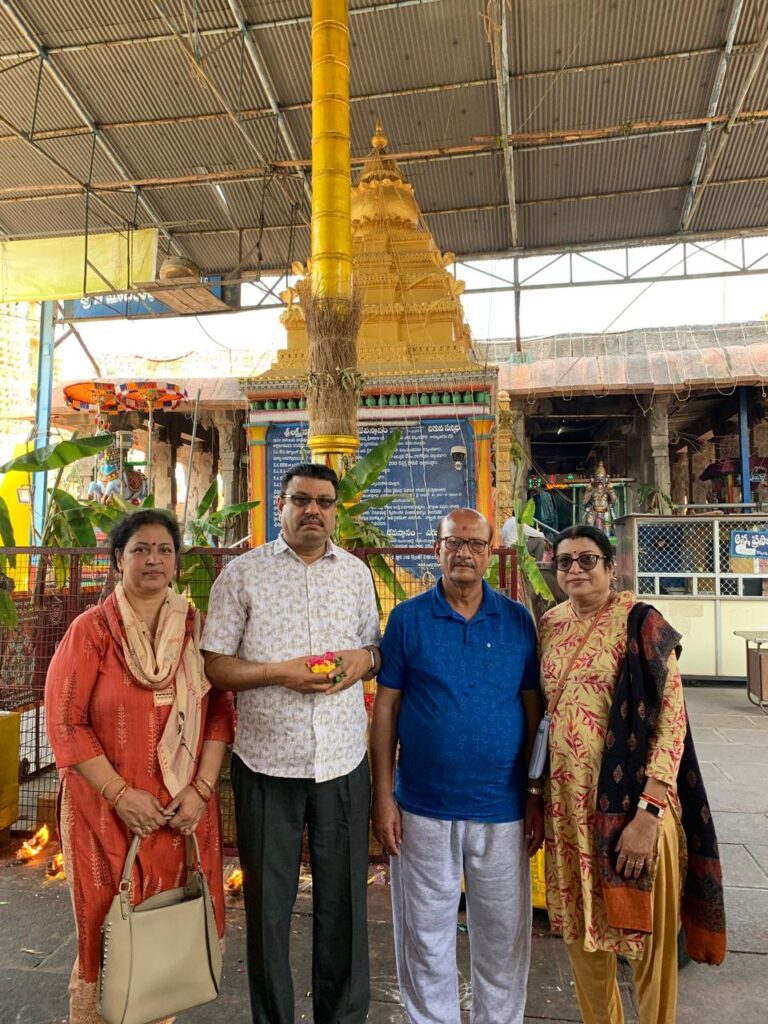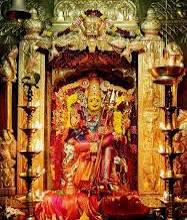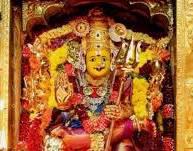Kanaka Durga Temple, Vijayawada:A Divine Experience: My Visit to the Majestic Kanaka Durga Temple
By Lokanath Mishra
On Saturday, 15th March 2025, I had the privilege of visiting the revered Kanaka Durga Temple, situated in the heart of Vijayawada, Andhra Pradesh. Accompanied by my wife, brother-in-law, and his wife, we embarked on a spiritual journey to seek the blessings of Goddess Kanaka Durga.

As we entered the temple complex, we were struck by the majestic architecture and the serene atmosphere that pervaded the surroundings. The temple, situated on the Indrakila hill along the banks of the Krishna River, is a masterpiece of Dravidian architecture and a testament to the rich cultural heritage of India.

We made our way to the sanctum sanctorum, where we were fortunate enough to have an excellent darshan of the Goddess. The idol of Goddess Kanaka Durga, made of gold, is an awe-inspiring sight to behold. Depicted as an eight-armed fierce goddess, with her foot over the demon Mahishasura and her trident pointing towards him, the Goddess exudes an aura of power and majesty.
We also had the opportunity to conduct Abhiseka, a ritual that involves offering prayers and worship to the Goddess. As we performed the ritual, we felt a deep sense of connection with the divine. It was as if Maa Kanaka Durga was a living goddess, radiating her divine energy and blessings upon us.
One of the most striking aspects of our visit was the Ashribad, a sacred ritual in which the Goddess provides her blessings to the devotees. As we received the Ashribad, we felt a sense of peace and tranquility wash over us, as if our worries and concerns had been alleviated.
The Kanaka Durga Temple is renowned for its vibrant festivals and celebrations, particularly the nine-day Navaratri festival. During this period, the Goddess is worshipped in nine different forms, each representing a distinct aspect of her divine power.
As we explored the temple complex, we were struck by the rich history and cultural significance of the temple. The Kanaka Durga Temple has been mentioned in various scriptures and literature since time immemorial, and its architecture is a blend of Dravidian and Vijayanagara styles.
Our visit to the Kanaka Durga Temple was a truly unforgettable experience. The temple’s stunning architecture, vibrant festivals, and mythological significance make it a must-visit destination for anyone interested in exploring the rich cultural and spiritual heritage of India.
As we left the temple complex, we felt grateful for the opportunity to experience the divine energy of Maa Kanaka Durga. We knew that our visit would remain etched in our memories forever, and we looked forward to returning to this sacred site again in the future.
Best Time to Visit:
The best time to visit the Kanaka Durga Temple is during the winter season, from October to March, when the weather is pleasant and conducive to exploration.
Unveiling the History and Significance of Maa Kanaka Durga Temple:
The Kanaka Durga Temple, situated on the Indrakila hill along the banks of the Krishna River, has a rich history that dates back to the 10th century A.D. The temple is believed to have been built by the western Chalukya King Tribhuvanamalla, who ruled the region during that period.
According to legend, the temple was constructed after the King had a divine vision of Goddess Kanaka Durga, who instructed him to build a temple in her honor. The King, who was a devout follower of the Goddess, immediately began construction of the temple, which was completed in a remarkably short period.
The temple’s architecture is a blend of Dravidian and Vijayanagara styles, with intricate stone carvings and sculptures adorning its walls. The temple complex is surrounded by a high wall, with a majestic gopuram (tower) that serves as the entrance.
The Idol of Goddess Kanaka Durga:
The idol of Goddess Kanaka Durga is made of gold and is depicted as an eight-armed fierce goddess, with her foot over the demon Mahishasura and her trident pointing towards him. The Goddess is shown in a fierce pose, symbolizing her victory over evil.
The idol is believed to be ‘Swayambhu’ or self-manifested, which adds to its spiritual significance. The Goddess is worshipped in nine different forms during the Navaratri festival, each representing a distinct aspect of her divine power.

Methodology Behind the Temple:
The Kanaka Durga Temple is built according to the principles of Vastu Shastra, an ancient Indian architectural science that emphasizes the importance of aligning buildings with the natural environment.
The temple’s design and layout are believed to have been inspired by the principles of Vastu Shastra, which aim to create a harmonious balance between the built environment and the natural world.
The temple’s orientation, layout, and design are all carefully planned to ensure that the devotees who visit the temple experience a sense of peace, tranquility, and spiritual upliftment.
Rituals and Practices:
The Kanaka Durga Temple is known for its vibrant festivals and celebrations, particularly the Navaratri festival, which is celebrated with great fervor and enthusiasm.
During the festival, the Goddess is worshipped in nine different forms, each representing a distinct aspect of her divine power. The festival is a time for devotees to come together and celebrate the victory of good over evil.
The temple also follows a strict routine of rituals and practices, including daily pujas, abhishekams, and archanas. The temple’s priests and devotees follow a rigorous schedule of worship and devotion, which is believed to bring spiritual benefits and blessings to the devotees.
In conclusion, the Kanaka Durga Temple is a sacred site that embodies the spiritual and cultural heritage of India. Its rich history, stunning architecture, and vibrant festivals make it a must-visit destination for anyone interested in exploring the depths of Indian spirituality and culture.
The Serene Surroundings and Divine Experience of Kanaka Durga Temple

As we stepped out of the Kanaka Durga Temple complex on the morning of 15th March 2025, we were enveloped by the serene surroundings of the Indrakila hill. The gentle breeze carried the sweet fragrance of flowers and the soothing sounds of birds chirping, creating a tranquil atmosphere that seemed to wash away all our worries and concerns.
The hill, surrounded by the majestic Krishna River, offered breathtaking views of the surrounding landscape. As we walked around the temple complex, we noticed the well-manicured gardens and the neatly maintained pathways, which added to the overall sense of peace and serenity.
The surrounding area is also dotted with several smaller temples and shrines, each with its own unique history and significance. We spent some time exploring these temples, learning about their history and mythology.
A Deep Sense of Peace and Satisfaction
As we completed our darshan and stepped out of the temple complex, we felt a deep sense of peace and satisfaction. The experience of worshipping Goddess Kanaka Durga had been truly uplifting, and we felt grateful for the opportunity to visit this sacred site.
We felt as though our worries and concerns had been lifted, and we were filled with a renewed sense of hope and optimism. The experience had been truly transformative, and we knew that it would stay with us for a long time.
I felt a special connection to the Goddess, as she is also worshipped in my home state of Odisha. In fact, Mata Kanaka Durga was worshipped in my village, Kasi Jaganath Pur, but was later shifted to Basudeba Pur Sasan, a nearby village. My grandfather, Balabhadra Mishra, was born in Basudeba Pur Sasan and later settled in Kasi Jaganath Pur.
The darshan of Maa Kanka Durga in the month of Chaitra is particularly unique and special. As we made our way back to our guest house, we couldn’t help but feel grateful for the experience.
A Truly Enriching Experience
The visit to the Kanaka Durga Temple had been a truly enriching experience, one that had touched our hearts and souls. We knew that we would always treasure the memories of our visit to this sacred site, and we looked forward to returning again in the future.
We felt blessed to have received the darshan of Goddess Kanaka Durga, and we knew that we would always carry her blessings with us. The experience had been truly unforgettable, and we looked forward to sharing it with others.


